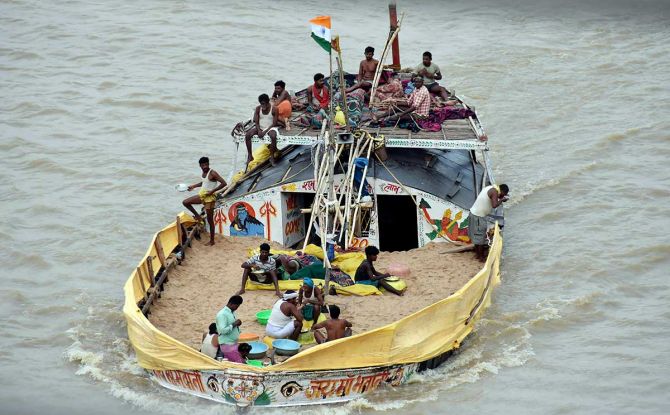The demand for minerals, boulders and sand is so great that it has fueled a black market and the goons who control this trade do not hesitate to kill law enforcement officers and reporters who have tried to expose them.
Rashme Sehgal reports.

The Uttar Pradesh police have acquired a reputation for being trigger happy. After the recent incident in Bharatpur village in Udham Singh Nagar, Uttarakhand, where a UP police team reportedly shot a local BJP leader's wife, the police from both states -- UP and Uttarkhand -- have hurled accusations at each other.
The UP police reportedly suspected that Zafar Ali, a member of the sand mafia, was hiding in the BJP leader's house, which led to the shootout.
This case once again highlights just how tenacious the links are between the sand mining mafia and politicians.
Every river in the country is under siege. The sand mining mafia blatantly use huge trucks to excavate sand from the river banks and carry it to dumping sites located in our cities.
Udham Singh Nagar is no exception. Located at the foothills of the Himalayas, it is strewn with rivers and rivulets which provide a ready source of material for the sand mining mafia.
The sand mining mafia, more emboldened in the last decade, does not hesitate to murder police officers, Indian Forest Service officers and local government functionaries who try to prevent their operations.
In August, Deputy Superintendent of Police Surender Singh Bishnoi was mowed down by a dumper truck during a raid he was conducting to check illegal mining in Haryana's Nuh district.
While the Haryana police claims to have arrested the driver of the dumper truck, a senior Haryana police officer says on condition of anonymity, "We know who is heading these operations in our state, but our hands are tied."
After the sale of liquor, the quickest way for politicians to earn a fast buck is from the sale of minerals, boulders and sand.
All three are highly lucrative commodities required to feed the real estate and infrastructure industries.
The demand for minerals, boulders and sand is so great that it has fueled a black market and the goons who control this trade do not hesitate to kill law enforcement officers and reporters who have tried to expose them.
According to data collected by the South Asia Network on Dams, Rivers and People, 418 people lost their lives and another 434 sustained injuries in sand mining related violence and accidents between December 2020 and March 2022.
In March this year, a Haryana road transport official and a truck driver were burnt to death for having dared to expose large scale illegal mining on the banks of the Yamuna.
UP has the worst record amongst all our states having witnessed 102 deaths and 90 injuries in cases of sand mining operations according to data accessed by the South Asia Network on Dams, Rivers and People team.
The mafia targeted a police team in Agra in 2021 burning their vehicles and a police check post following the accidental death of a sand tractor driver.

Bihar has seen 20 violent attacks by the sand mafia, injuring 48 policemen, in the last 18 months. Fearing their clout, many police officials prefer to turn a blind eye to their operations.
Morena in Madhya Pradesh witnessed a vicious attack when Shradha Pandre, a daring woman sub divisional forest officer, was attacked by 100 men wearing masks carrying stones and sticks.
Pandre was attacked because she seized a tractor carrying sand. This incident occurred in 2021. Fortunately, Pandre managed to survive the attack.
The Chambal river area, close to where Pandre was attacked, is a hot bed of the sand mafia who operate with impunity.
Incidentally, the Madhya Pradesh government recently came up with an unusual proposal of denotifying 29,239 hectares in the Chambal wildlife sanctuary to make it available for 'legal' sand mining.
Men carrying assault rifles guard sand mining operations along the Narmada river. The Narmada river area is dotted with earth movers and JCB machines removing sand and driving it into larger cities.

Sand mining constitutes only one mineral loss running into several thousand crore rupees every year.
India presently produces 95 different minerals and the mining industry in India is worth about Rs 3 lakh crore.
In 2020-2021, it was worth Rs 294,644 crore.
Although sand mining is only one amongst several minerals being mined in the country, the problem with its mining is that it affects water security.
Manoj Mishra, an activist who has spent decades fighting to save the Yamuna, observed, "Mining and sand mining in particular are part of the political economy. These operations are run by local politicians. It allows for low investment at very low risk, but gives back very high profits. So everyone has made a beeline for it."
According to a Union environment ministry report, 416,000 incidents of illegal mining were reported between 2013 and 2017.
According to this report, there are 100,000 incidents of illegal mining discovered in the country each year. When the numbers of illegal mining occurences are further broken down, it works out to 8,833 incidents every month; 294 incidents every day; 12 incidents every hour.
Most of these illegal mining cases never reach the court or the police.
In 2016, 107,609 cases of illegal mining were reported. Of these, FIRs were registered only in 6,033 cases.
Rampant sand mining has lowered the river bed of most of our rivers, affecting their flow. Huge craters have been created which can contaminate river acquifers as has happened with the Yamuna and Hindon rivers in Noida and Greater Noida.
Ultimately, our rivers are affected and this will impact India's water security.
Feature Presentation: Ashish Narsale/Rediff.com










